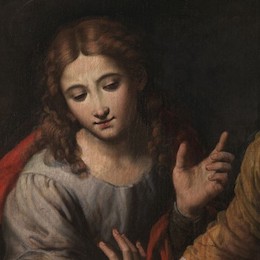Théodore Van Loon
1582 (Erkelenz, Pays-Bas espagnols) / 1649 (Maastricht, Pays-Bas)
Living in : Flandre et Italie
Working in : Flandre et Rome
Théodore van Loon – born in Erkelenz in the Spanish Netherlands in 1582 but who can be found pounding the pavement of Rome in the district of Santa Maria del Popolo (where Merisi officiates) between 1602 and (perhaps) 1612 – infused with devotional and popular pietism early Caravaggism, which had not yet succumbed to the commercial method of Manfredi. To the triumphal pomp of Rubens, van Loon opposes, according to the humanist Erycius Puteanus, a solemn and silent Theatro miraculorum, that is to say a theater of flesh capable of working miracles. Concerned in his early days with classical realism, as taught at the Academia di San Luca (where he was admitted in 1604) and as brilliantly practiced by the new Bolognese school of the Carracci brothers, Theodore the Flemish produced a synthesis originality between Caravaggesque naturalism and Carracesque idealism. Close to the oratorian sensibility of Philipe Néri – he even brought back to Montaigu relics of the saint in 1628 – Van Loon creates dazzling great spiritual concerts filled with bright colors and dark nights, with a robust and round construction, as healthy as red cheeks of little Flemings.
Theodore van Loon
by Paulus Pontius (Paulus Du Pont), after Sir Anthony van Dyck
engraver, before 1658
National Portrait Gallery, Londres.
Living in : Flandre et Italie
Working in : Flandre et Rome
Théodore van Loon – born in Erkelenz in the Spanish Netherlands in 1582 but who can be found pounding the pavement of Rome in the district of Santa Maria del Popolo (where Merisi officiates) between 1602 and (perhaps) 1612 – infused with devotional and popular pietism early Caravaggism, which had not yet succumbed to the commercial method of Manfredi. To the triumphal pomp of Rubens, van Loon opposes, according to the humanist Erycius Puteanus, a solemn and silent Theatro miraculorum, that is to say a theater of flesh capable of working miracles. Concerned in his early days with classical realism, as taught at the Academia di San Luca (where he was admitted in 1604) and as brilliantly practiced by the new Bolognese school of the Carracci brothers, Theodore the Flemish produced a synthesis originality between Caravaggesque naturalism and Carracesque idealism. Close to the oratorian sensibility of Philipe Néri – he even brought back to Montaigu relics of the saint in 1628 – Van Loon creates dazzling great spiritual concerts filled with bright colors and dark nights, with a robust and round construction, as healthy as red cheeks of little Flemings.
Theodore van Loon
by Paulus Pontius (Paulus Du Pont), after Sir Anthony van Dyck
engraver, before 1658
National Portrait Gallery, Londres.
